
- •Textbook Series
- •Contents
- •Introduction
- •1 ICAO Annex 6
- •Introduction
- •Compliance with the Law
- •Operational Control
- •Safety
- •Alternate Aerodromes
- •Flight time
- •Flight Safety and Accident Prevention
- •Maintenance Release
- •Lighting of Aircraft
- •Navigation Lights
- •Questions
- •Answers
- •2 EU-OPS General Requirements
- •Applicability
- •Common Language
- •Quality System
- •Accident Prevention and Flight Safety Programme
- •Additional Crew Members
- •Ditching
- •Carriage of Persons
- •Crew Responsibilities
- •Responsibilities of the Commander
- •Authority of the Commander
- •Admission to the Flight Deck
- •Unauthorized Carriage
- •Portable Electronic Devices
- •Drugs and Alcohol
- •Endangering Safety
- •Documents to Be Carried
- •Manuals to Be Carried
- •Additional Information and Forms to Be Carried
- •Information to Be Retained on the Ground
- •Power to Inspect
- •Production and Preservation of Documents and Recordings
- •Leasing of Aeroplanes
- •Questions
- •Answers
- •3 Operator Supervision and Certification
- •Rules for the Certification of an Air Operator
- •Applicant Requirements
- •Aeroplane Maintenance
- •Variation, Revocation or Suspension of an AOC
- •Key Post Holders within the Operation
- •Main Operating Base
- •Aeroplanes
- •Other Considerations
- •Contents and Conditions of an AOC
- •Terminology
- •Operations Manual (OM)
- •General Rules for Operations Manuals
- •Ops Manual Amendments
- •Competence of Operations Personnel
- •Aeroplane Maintenance
- •Questions
- •Answers
- •4 Operational Procedures
- •Establishment of Procedures
- •Use of Air Traffic Control
- •Authorization and Selection of Aerodromes by the Operator
- •Meteorological Conditions
- •Approach and Landing Conditions
- •Aerodrome Operating Minima (AOM)
- •Commencement and Continuation of Approach
- •Instrument Departure and Approach Procedures
- •Noise Abatement Procedures
- •Routes and Areas of Operation
- •RVSM Operations
- •Operations in MNPS Airspace
- •Maximum Distance from an Adequate Aerodrome for Two-engine Aeroplanes without an ETOPS Approval
- •Extended Range Operations with Twin-engine Aeroplanes (ETOPS)
- •Establishment of Minimum Flight Altitudes
- •Fuel Policy
- •Carriage of Persons with Reduced Mobility (PRMs)
- •Carriage of Inadmissible Passengers, Deportees or Persons in Custody
- •Stowage of Baggage and Cargo and Galley Equipment
- •Passenger Seating
- •Passenger Briefing
- •Flight Preparation
- •ATS Flight Plan
- •Refuelling and De-fuelling
- •Crew Members at Duty Stations
- •Seats, Safety Belts and Harnesses
- •Smoking
- •Ice and Other Contaminants
- •Use of Supplemental Oxygen
- •Ground Proximity Detection
- •Occurrence Reporting
- •Questions
- •Answers
- •5 All Weather Operations
- •Introduction
- •Aerodrome Operating Minima: Operator’s Responsibility
- •Classification of Aeroplanes
- •Terminology
- •Take-off Minima
- •Visual Reference
- •Required RVR/Visibility
- •Figure 5.2 Exceptions
- •System Minima
- •Non-precision Approach
- •Minimum Descent Height
- •Visual Reference
- •Required RVR
- •No Decision Height Operations
- •Visual Reference
- •Category III RVR Requirements
- •Circling
- •Visual Approach
- •VFR Operating Minima
- •Special VFR
- •Questions
- •Answers
- •6 Aeroplane Equipment and Instruments
- •Introduction
- •Basic Requirements
- •Internal Doors and Curtains
- •First Aid Kits
- •First Aid Oxygen
- •Break-in Markings
- •Means of Emergency Evacuation
- •Cockpit Voice Recorders (CVRs)
- •Summary
- •CVRs – Operation, Construction and Installation
- •Flight Data Recorders (FDRs)
- •Summary
- •Equipment for Compliance with Flight Rules
- •Single-pilot IFR Operations
- •Altitude Alerting System
- •Standby Horizon
- •Aeroplane Lighting
- •Flights over Water
- •Long Range Flights
- •Weather Radar
- •Equipment for Operations in Icing Conditions
- •Machmeter
- •ACAS
- •Communications Equipment
- •Internal Communications
- •Audio Selector Panel (ASP)
- •Navigation Equipment
- •Instrument Procedures
- •Installation
- •Electrical Circuit Fusing
- •Windshield Wipers
- •Items not Requiring Approval
- •Seats and Harnesses
- •‘Fasten Seat Belts’ and ‘No Smoking’ Signs
- •Carriage and Use of Supplemental Oxygen
- •Crew Protective Breathing Equipment (PBE)
- •Crash Axes and Crowbars
- •Megaphones
- •Emergency Lighting
- •Emergency Locator Transmitter (ELT)
- •Survival Equipment
- •Questions
- •Answers
- •7 Crew, Logs and Records
- •Crew Composition
- •Commander
- •Relief of the Commander
- •Relief of the Co-pilot
- •System Panel Operator
- •Relief of System Panel Operator
- •Minimum Flight Crew for Operations under IFR or at Night
- •Conversion, Training and Checking
- •Type Rating
- •Conversion Training
- •Difference and Familiarization Training
- •Recurrent Training and Checking
- •Operator Proficiency Check
- •Line Checks
- •Emergency and Safety Equipment Training and Checking
- •Crew Resource Management (CRM) Training
- •Ground and Refresher Training
- •Aeroplane/STD Training
- •Pilot Qualifications to Operate in Either Pilot Seat
- •Recent Experience
- •Route and Aerodrome Qualification for Commander or PF
- •Operations on More Than One Type or Variant
- •Operation of Aeroplanes and Helicopters
- •Training Records
- •Cabin Crew
- •Journey Log
- •Operational Flight Plan (OFP)
- •Storage Periods
- •Flight and Duty Time Limitations
- •Questions
- •Answers
- •8 Long Range Flight and Polar Navigation
- •Navigation System Degradation
- •Course and INS Cross-checking
- •Unable to Continue in Accordance with ATC Clearance
- •Polar Navigation
- •Grid Navigation
- •Minimum Time Routes
- •Questions
- •Answers.
- •Introduction
- •Considerations
- •References
- •Transoceanic Navigation Problems
- •The Airspace
- •MNPS Authority
- •RVSM
- •Navigation System Requirements
- •Navigation System Serviceability
- •NAT Tracks
- •OTS Track Designation
- •OTS Changeover
- •Track Message Identifier (TMI)
- •Track Routings
- •Allocation of FLs
- •Domestic Routes
- •Polar Track Structure (PTS)
- •Other Routes within NAT MNPS Airspace
- •Route Structures Adjacent to NAT MNPS Airspace
- •Brest Oceanic Transition Area (BOTA)
- •Communications
- •SELCAL
- •Position Reports
- •Radio Failure in the North Atlantic Area
- •Initial Clearance
- •Transition
- •Meteorological Reports
- •Special Contingencies and Procedures
- •Strategic Lateral Offset Procedure (SLOP)
- •Deviation Around Severe Weather
- •Unable to Obtain Revised Clearance
- •Navigation System Failure
- •Errors Associated with Oceanic Clearances
- •Pre-flight and In-flight Procedures
- •Questions
- •Answers.
- •10 Special Operational Procedures and Hazards
- •Operating Procedures
- •Minimum Equipment List (MEL) and Master Minimum Equipment List (MMEL)
- •Ground De-icing and Anti-icing Procedures
- •The Clean Aircraft Concept
- •Bird Strike Risk and Avoidance
- •Hazard to Aeroplanes
- •Bird Strike Report
- •Incompatible Land Use around Airports
- •Noise Abatement
- •Questions
- •Answers
- •11 Fire and Smoke
- •Fire and Smoke
- •Fire in the Aeroplane
- •The Number and Location of Hand-held Fire Extinguishers
- •Smoke
- •Crew Protective Breathing Equipment (PBE)
- •Crash Axes and Crowbars
- •Overheated Brakes
- •Questions
- •Answers
- •12 Pressurization Failure
- •Pressurization Failure
- •Questions
- •Answers
- •13 Windshear and Microburst
- •Windshear and Microburst
- •Questions
- •Answers
- •14 Wake Turbulence
- •Wake Turbulence
- •Questions
- •Answers
- •15 Security
- •Security
- •Questions
- •Answers
- •16 Emergency and Precautionary Landings
- •Emergency and Precautionary Landings
- •Ditching
- •Precautionary Landing
- •Passenger Briefing
- •Evacuation
- •Megaphones
- •Questions
- •Answers
- •17 Fuel Jettison
- •Fuel Jettison
- •Jettison System Certification Requirement
- •Jettisoning Procedure
- •Safety
- •Questions
- •Answers
- •18 Transport of Dangerous Goods by Air
- •Transport of Dangerous Goods by Air
- •Technical Instructions
- •Labelling and Packaging
- •Loading Restrictions
- •Provision of Information
- •Emergencies
- •Training
- •Accident and Incident Reporting
- •Acceptance of Dangerous Goods
- •Inspection for Damage, Leakage or Contamination
- •Labelling
- •Questions
- •Answers
- •19 Contaminated Runways
- •Contaminated Runways
- •Contaminated Runway
- •Damp Runway
- •Wet Runway
- •Dry Runway
- •Contaminant Depth Limitations
- •Aquaplaning (Hydroplaning)
- •Braking Action
- •Coefficient of Friction
- •Performance Considerations
- •SNOWTAMs
- •Questions
- •Answers
- •20 Revision Questions
- •Questions
- •Answers
- •21 Index

Transport of Dangerous Goods by Air
UN Number
The four digit number assigned by the United Nations Committee of Experts on the Transport of Dangerous Goods to identify a substance or a particular group of substances.
Unit Load Device
Any type of freight container, aircraft pallet with a net, or aircraft pallet with a net over an igloo.
Technical Instructions
ICAO publishes Technical Instructions for the Safe Transport of Dangerous Goods by Air (ICAO document 9284), and all operators are to take all reasonable measures to ensure that dangerous goods are packed as specified in the Technical Instructions. Articles that would normally be classified as dangerous goods in the Technical Instructions may be carried on board an aeroplane excluded from the provisions provided that they are:
•required to be aboard for operating reasons.
•carried as catering or cabin service supplies.
•for use in flight as veterinary aid or as a humane killer for an animal.
•carried for use in flight as medical aid for a patient, providing that:
•gas cylinders have been purpose manufactured.
•drugs etc. are under the control of trained person(s).
•equipment with wet cell batteries are kept upright.
•such items are stowed properly for take-off/landing.
•are carried by passengers or crew members.
Items carried as replacements for those detailed above, shall be carried in accordance with the Technical Instructions. An operator shall ensure that articles and substances or other goods declared as dangerous goods that are specifically identified by name or generally described in the Technical Instructions as being forbidden for transport under any circumstances are not carried on any aeroplane.
Labelling and Packaging
Operators are responsible for ensuring that all dangerous goods are carried and packed and labelled in accordance with the Technical Instructions. The shipper is responsible for checking that dangerous goods offered for transport are not forbidden items and are properly classified, packed marked and labelled and accompanied by the properly executed dangerous goods transport documentation (Annex 18-Technical Instructions). Operators are required to produce and follow a checklist (the Acceptance Checklist) for the acceptance procedure for dangerous goods.
Loading Restrictions
Only dangerous goods specified in the Technical Instructions are to be carried in passenger cabins or on the flight deck. Where carried in the cargo compartments, goods are to be loaded, segregated, stowed and secured as specified in the Technical Instructions. Where goods are marked ‘Cargo Aircraft Only’, operators are to ensure that such goods are loaded in accordance with the Technical Instructions in dedicated cargo aeroplanes. If radioactive material is carried, the radiation exposure of transport and storage personnel must be so controlled that none of them are likely to receive a radiation dose in excess of that permitted for members of the public.
18
Transport of Dangerous Goods by Air 18
221

18 Transport of Dangerous Goods by Air
Provision of Information
When dangerous goods are carried on an aeroplane, the operator is to provide the commander with the required written information as specified in the Technical Instructions. The OM (Part A section 9) is to include information to enable the flight crew to carry out its responsibilities for the carriage of dangerous goods and also the actions to be taken in the event of an emergency. Passengers are to be informed of the types of dangerous goods that must not be carried on an aeroplane. As a minimum, the information should consist of warning notices or placards prominently displayed where tickets are sold, passengers checked in, boarding areas and luggage check in areas. A warning note may be printed on the ticket or ticket jacket. Any such warning issued to passengers may include reference to dangerous goods that may be carried. For persons offering goods for carriage, information is to be made available and prominently displayed containing warnings about dangerous goods.
Emergencies
If an in-flight emergency occurs, the pilot in command should inform ATC for the information of the airport authorities, of any dangerous goods on board. The operator is required to inform the State in which the accident/incident has occurred that the aircraft was carrying dangerous goods.
Training
Dangerous goods training programmes are to be established and updated in accordance with the requirement of the Technical Instructions.
Air by Goods Dangerous of Transport 18
Accident and Incident Reporting
An operator must report dangerous goods incidents and accidents to the Authority and the appropriate Authority in the State where the accident or incident occurred. The first report should be despatched within 72 hours of the event unless exceptional circumstances prevent this and include the details that are known at that time. If necessary, a subsequent report must be made as soon as possible. Reports are also to be submitted if undeclared or misdeclared dangerous goods are discovered in cargo or passengers’ baggage.
Acceptance of Dangerous Goods
(a) An operator shall not accept dangerous goods unless:
1.the package, overpack or freight container has been inspected in accordance with the acceptance procedures in the Technical Instructions;
2.except when otherwise specified in the Technical Instructions, they are accompanied by two copies of a dangerous goods transport document.
3.the English language is used for:
(i)package marking and labelling; and
(ii)the dangerous goods transport document,
in addition to any other language requirements.
222
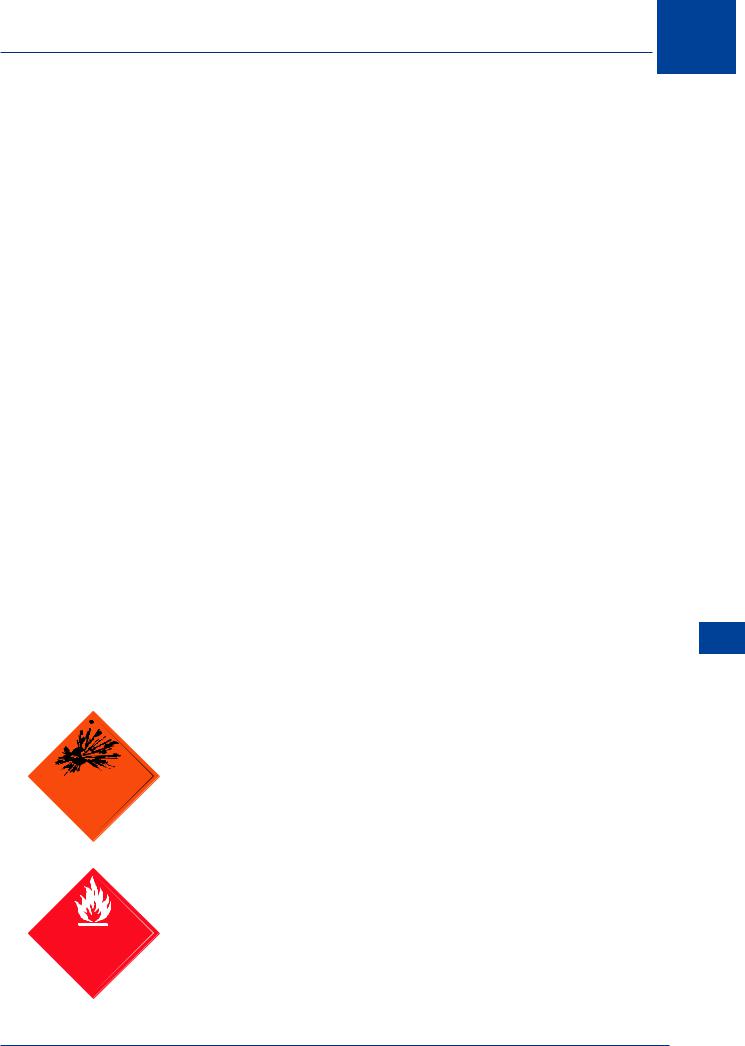
Transport of Dangerous Goods by Air 18
(b) An operator shall use an acceptance checklist which shall allow for all relevant details to be checked and shall be in such form as will allow for the recording of the results of the acceptance check by manual, mechanical or computerized means.
Inspection for Damage, Leakage or Contamination
(a) An operator shall ensure that:
1.Packages, overpacks and freight containers are inspected for evidence of leakage or damage immediately prior to loading on an aeroplane or into a unit load device, as specified in the Technical Instructions;
2.A unit load device is not loaded on an aeroplane unless it has been inspected as required by the Technical Instructions and found free from any evidence of leakage from, or damage to, the dangerous goods contained therein;
3.Leaking or damaged packages, overpacks or freight containers are not loaded on an aeroplane;
4.Any package of dangerous goods found on an aeroplane and which appears to be damaged or leaking is removed or arrangements made for its removal by an appropriate Authority or organization. In this case the remainder of the consignment shall be inspected to ensure it is in a proper condition for transport and that no damage or contamination has occurred to the aeroplane or its load; and
5.Packages, overpacks and freight containers are inspected for signs of damage or leakage upon unloading from an aeroplane or from a unit load device and, if there is evidence of damage or leakage, the area where the dangerous goods were stowed is inspected for damage or contamination.
Labelling
The following labels are used to identify Dangerous Goods. The numbers refer to the Hazard Classes.
Explosive
Symbol (exploding bomb): Black
Background: Orange
|
** Place for division and compatibility group |
*1* |
Note: Packages bearing this label marked Division 1.1 or 1.2 are not |
normally permitted for transport by air. |
Gas Flammable
Symbol (flame): |
Black or white |
Background: |
Red |
2
Transport of Dangerous Goods by Air 18
223
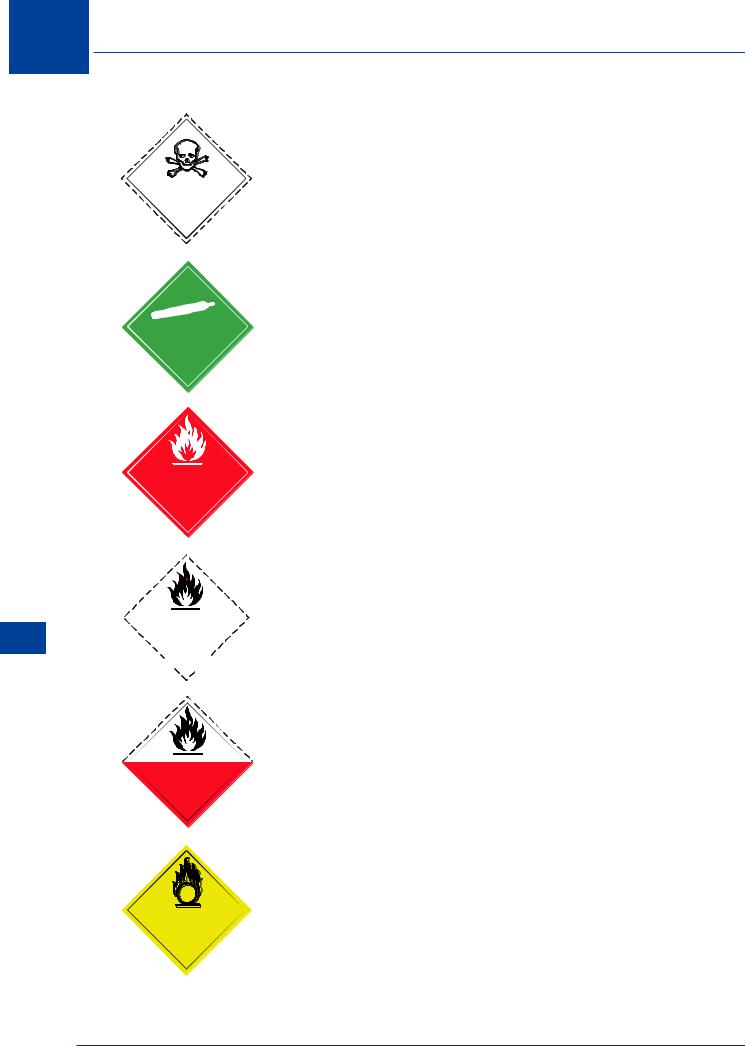
18 Transport of Dangerous Goods by Air
Air by Goods Dangerous of Transport 18
GasToxic
Symbol (skull and crossbones): |
Black |
Background: |
White |
2
Gas Non-flammable
Symbol (gas cylinder): |
White |
Background: |
Green |
2
Liquid Flammable
Symbol (flame): |
Black or white |
Background: |
Red |
3
Solid Flammable
|
Symbol (flame): |
Black |
|
Background: |
White with seven vertical red |
|
||
|
|
stripes |



 4
4 



Spontaneous Combustion
Symbol (flame): |
Black |
Background: |
Upper half white, lower half red |
4 |
|
Oxidizer
Symbol (flame over circle): |
Black |
Background: |
Yellow |
Figure ‘5.1’ in bottom corner |
|
5.1 |
|
224
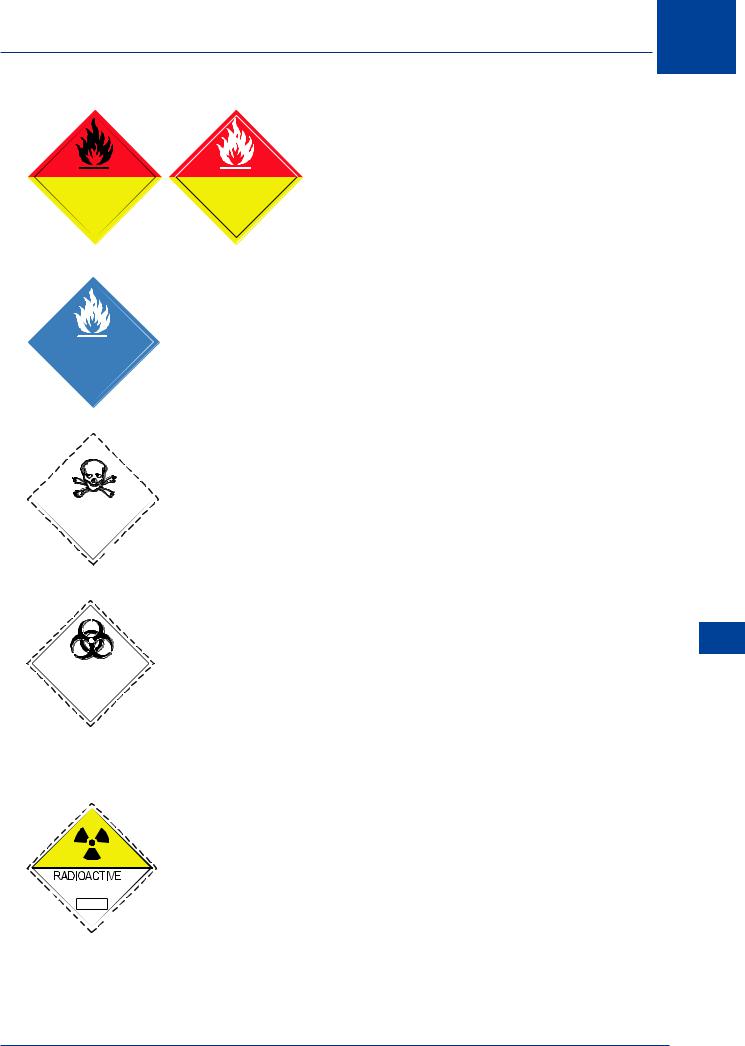
Transport of Dangerous Goods by Air 18
Organic Peroxide
|
|
Symbol (flame): |
Black or white |
|
|
Background: |
Upper half red, lower half |
|
|
|
yellow |
5.2 |
5.2 |
Figure ‘5.2’ in bottom corner |
|
|
|
||
Danger IfWet
Symbol (flame): |
Black or white |
Background: |
Blue |
4
Toxic
Symbol (skull and crossbones): |
Black |
Background: |
White |
6 



Infectious
The bottom part of the label should bear the inscription “INFECTIOUS SUBSTANCE - in case of damage or leakage immediately notify public health authority”
|
Symbol (three crescents superimposed on a circle) and |
|
6 |
inscription: |
Black |
|
Background: |
White |
Figure ‘6’ in bottom corner
CONTENTS.......................
ACTIVITY........................
TRANSPORT INDEX
7 



Radioactive
Radioactive material, Class 7, Category II — Yellow
|
Symbol (trefoil) |
Black |
|
Background: |
Top half yellow with white border, |
|
|
bottom half white |
|
|
Text (mandatory), black in bottom half of label: “Radioactive”; “Contents.....”; “Activity.....”; in a black outlined box — “Transport Index”.
Two (2) red vertical stripes must follow the word “Radioactive”.
Transport of Dangerous Goods by Air 18
225
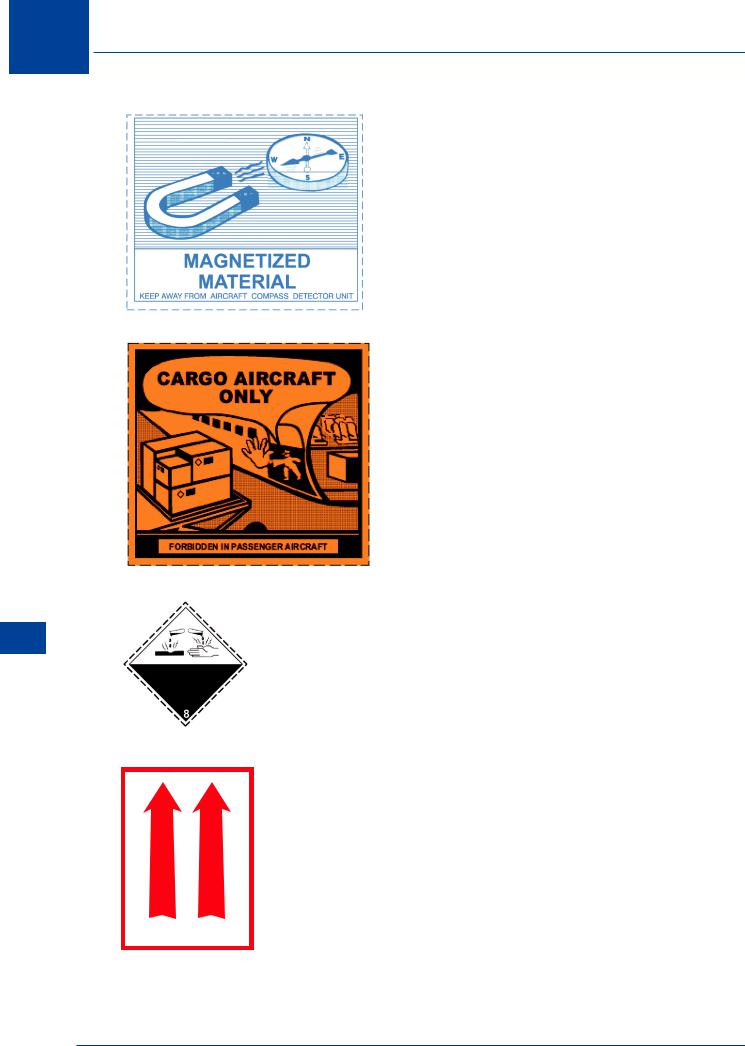
18 Transport of Dangerous Goods by Air
Air by Goods Dangerous of Transport 18
Magnetized Material
Colour: |
Blue on white |
Dimensions: |
110 mm × 90 mm |
Cargo Aircraft Only
Colour: |
Black on orange |
Dimensions: |
120 mm × 110 mm |
Corrosive
Symbol (liquids spilling from two glass vessels and attacking a hand and
a metal): |
Black |
Background: |
Upper half white, lower half black with white border |
Package Orientation
|
Colour: |
Red or black on a contrasting background |
|
Dimensions: |
74 mm × 105 mm |
|
|
|
|
|
|
226
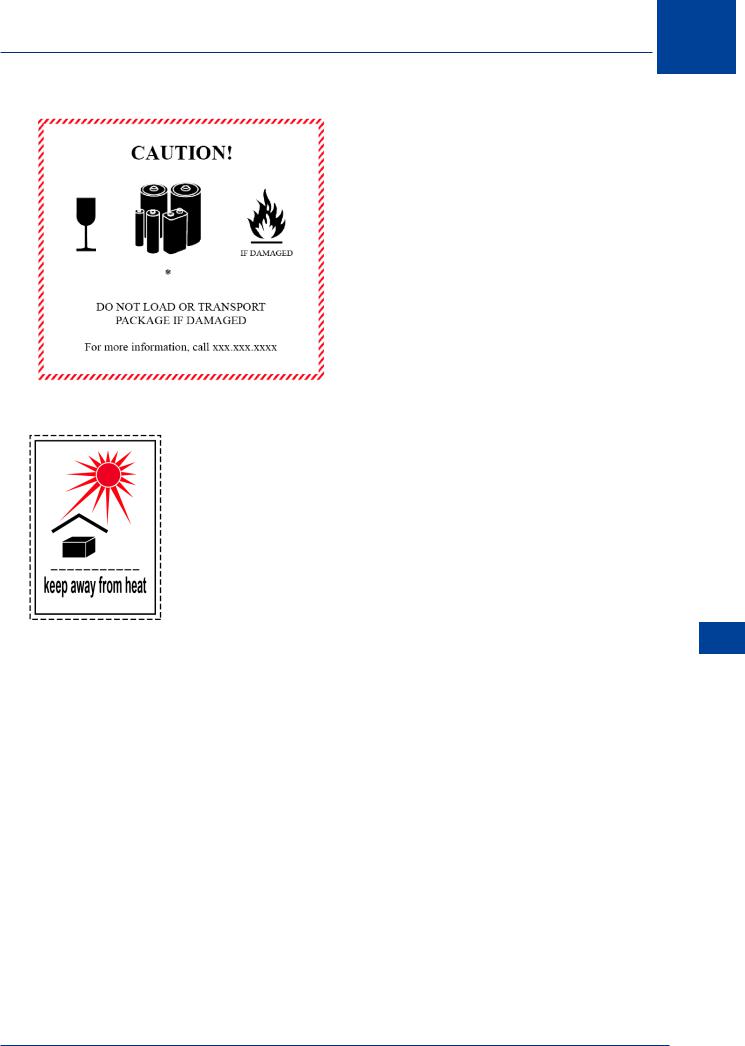
Transport of Dangerous Goods by Air 18
Lithium Battery Handling Label
Colour: |
Black on a contrasting |
|
background |
Dimensions: |
120 mm × 110 mm |
* Place for “Lithium ion battery” and/or “Lithium metal battery”
Keep Away from Heat
Colour: |
Red or black on a white background |
Dimensions: |
74 mm × 105 mm |
Transport of Dangerous Goods by Air 18
227
